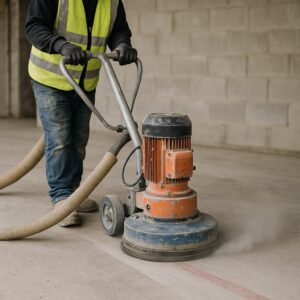Construction
Concrete Grinding and Crushing: Techniques, Benefits, and Safer Practices
Key Takeaways
- Concrete grinding and crushing are vital for transforming demolished structures and old surfaces into valuable resources, promoting sustainability in modern construction.
- New machinery and advanced techniques lead to greater efficiency, safer working environments, and higher-quality end results.
- Effective dust control, comprehensive worker protection, and robust recycling practices are essential for both workforce health and environmental stewardship.
- Following established safety guidelines and embracing new technologies reduces risks and enhances project outcomes.
- Workplace safety regulations are a necessary foundation for healthy, productive job sites.
- Utilizing processed concrete in new applications supports a circular economy and eases pressure on landfills and natural resources.
What Is Concrete Grinding and Crushing?
Behind every gleaming new floor, freshly paved road, or reclaimed city block, concrete grinding and crushing play a fundamental role. Grinding is the process of smoothing, flattening, or polishing a concrete surface to prepare it for coatings, decorative finishes, or safe foot traffic. This can include removing stubborn adhesives, paint residue, surface imperfections, or even correcting uneven slabs. Crushing, meanwhile, handles the heavy lifting of reducing large slabs or whole structures down to aggregate size—the small, reusable stone and gravel-like pieces needed for countless new construction projects. Professional guidance from a skilled concrete contractor ensures these operations meet rigorous safety, quality, and environmental standards, transforming what was once demolition debris into a valuable reusable resource. These processes are essential to a variety of industries, not just restricted to commercial or public works. Residential renovations, highway maintenance, and even industrial site reclamation projects rely on grinding and crushing to ensure surfaces meet safety codes or to generate recycled material for new construction. Innovations and stricter regulations have evolved these once labor-intensive tasks into streamlined operations, marked by improved precision, less dust, and stronger ecological responsibility. Where once concrete waste may have been carted off to a landfill, now there is a clear pathway for its reuse within the construction supply chain.
Modern Equipment and Techniques
Today’s construction sites bear little resemblance to those a decade ago, thanks to rapid machinery and process engineering developments. Advanced diamond grinders and compact, high-powered crushers now lead the industry, often featuring fully integrated dust extraction systems and remote or even autonomous controls. These innovations mean that trained operators can tackle both large open slabs and tight, awkwardly shaped spaces with unparalleled speed and accuracy. For example, a warehouse concrete resurfacing job that once took a large crew several days can now be completed by a couple of skilled technicians in just a day, with better, more consistent results and far less physical strain. The trend is unmistakable: as noted by industry leaders, automation and smarter environmental controls are shaping the industry’s future. Machines now use onboard sensors and microprocessor controls to dynamically adjust cutting depth, grinder speed, and crushing force, resulting in minimal energy waste and improved safety. Tech-enabled diagnostics alert operators to potential issues before they become costly problems, further reducing downtime and ensuring machinery operates at peak performance throughout the project lifecycle.
Equally important for efficient material handling on sites that are recycling crushed concrete or placing fresh mixes is how the material is transported and deposited. In many tight or urban projects, a modern towable telescoping conveyor often outworks traditional concrete conveyor trucks by combining long reach with 240-degree rotation and variable speed control to place material precisely while reducing manual handling. These conveyors can move high throughputs and simplify cleanup—features that cut labor hours and minimize dust compared with repeated wheelbarrow or short-haul operations. Integrating them with on-site crushing and grinding workflows streamlines logistics and helps teams maintain cleaner, safer work zones without adding complexity.
Health and Safety on the Job Site
Grinding and crushing concrete may seem straightforward, but the safety challenges they present are significant. Silica dust, generated by the abrasive breaking and cutting of concrete, poses a severe risk to respiratory health. Chronic exposure without protection is linked to silicosis and even lung cancer, making effective dust management and worker protection non-negotiable. Leading crews use multiple techniques for dust control, including water suppression sprays, sealed extraction vacuums, and continuous air quality monitoring devices. Adequate personal protective equipment (PPE) is standard: respirators, goggles, gloves, protective suits, and ear defenders are all part of the daily uniform. Frameworks like the OSHA concrete manufacturing standards provide important requirements for safe practices, ranging from setup to finished product. Frequent safety briefings, signage, and an emphasis on open communication help teams stay aware of hazards and maintain a healthy, injury-free job site. Real-world application of these standards has contributed to a downward trend in job-related injuries in recent years.
Beyond airborne dust, managing the physical waste produced during concrete grinding is another important safety consideration. Debris buildup can create tripping hazards, obstruct workflows, and increase secondary dust exposure. For this reason, efficient job sites implement organized waste removal systems to keep work areas clean and reduce risks. For instance, the use of a construction dump box often allows crews to safely collect, contain, and transport heavy concrete waste with minimal manual effort. This practice not only enhances site safety but also keeps cleanup operations efficient and compliant with regulations.
Environmental Considerations and Recycling Benefits
With growing urban populations and a booming renovation market, construction waste is no minor concern. Fortunately, concrete is exceptionally suitable for recycling. Once crushed down, the concrete can be screened and sorted for use in a variety of ways: as subbase for new roads, for pipe bedding in drainage projects, or even in fresh concrete mixes for new builds. The scale is impressive—the EPA estimates that more than 140 million tons of concrete are recycled in the United States annually, a figure that spares valuable landfill space and preserves diminishing sources of raw aggregate.
Beyond the obvious waste diversion, recycling concrete helps minimize the environmental impact related to traditional quarry mining and material transport. Many contractors now track the carbon footprint associated with transporting, crushing, and reusing concrete, adopting shorter route logistics and cleaner-burning equipment. Ambitious green building standards and certifications such as LEED depend on these practices, rewarding projects that can demonstrate a robust materials recycling protocol. Builders and developers, in turn, benefit from both regulatory approval and a positive public image.
Best Practices for Concrete Grinding and Crushing
- Regularly inspect and maintain all grinding and crushing equipment before, during, and after shifts to prevent mechanical failure and ensure operational safety.
- Implement water suppression or powerful vacuum extraction systems directly at the source of dust production to control airborne particulates and protect worker respiratory health.
- To prevent unauthorized personnel access and minimize accident risk, create clearly delineated work zones using visual barriers, fencing, and signage.
- Thoroughly sort debris to maximize the value extracted—removing metals, plastics, and woods from recyclable concrete to enhance downstream utility and industry compliance.
- Conduct regular, practical safety training that covers new tools, evolving technologies, and updates in regulations, making sure every team member is both competent and confident on site.
Technology Trends Shaping the Industry
Digital transformation is well underway in the realm of concrete surface preparation and recycling. Automation has led to self-leveling grinders, autonomous transport vehicles, and even machine learning-driven workflow management apps. Smart sensors monitor equipment conditions in real time, allowing predictive maintenance to reduce unexpected breakdowns. On major projects, autonomous grinders are increasingly used to cover massive surface areas, delivering extremely consistent finishes with little direct human oversight. Environmental benefits amplify as well: software can help operators fine-tune grinding speeds and pressure, reducing wasted energy and lowering the project’s carbon footprint. Machine learning algorithms are harnessed to tweak performance as floor hardness or aggregate sizes shift, optimizing both quality outcomes and operational efficiency. These technological shifts put additional emphasis on workforce upskilling and ongoing digital literacy training throughout the industry.
Common Challenges and How to Overcome Them
Each project presents a unique blend of technical, logistical, and environmental challenges. Concrete mixtures can be highly variable, often depending on their original intended use and age. This impacts how aggressively grinding or crushing equipment must be set, and can quickly wear out tools if not properly planned. Urban sites can pose tight access, require quieter operations to meet local noise ordinances, and even have restrictions on heavy vehicle movement during certain hours, making flexible and compact machinery ever more critical. Mitigation strategies begin with careful preparation: site surveys to determine slab composition, condition, and access logistics; preemptive notifications to neighbors; and tailored equipment choices for noise and dust sensitivity. Many project teams use collaborative job-site management apps to streamline communications, share updates on changing conditions, and track productivity hour by hour. This level of coordination increases project success rates while also improving worker satisfaction. After construction activities are complete, managing leftover debris and dust often becomes essential for safety and aesthetics. Engaging professional construction cleanup services Dallas (or elsewhere) can help ensure the site is thoroughly cleaned, allowing for a smooth handover and maintaining a positive reputation with clients and neighbors.
Looking Ahead: Sustainability and Smarter Solutions
As global construction aims for higher sustainability targets, grinding and crushing concrete are now keys to both meeting regulations and reducing environmental impact. Adoption of recycled aggregates, investment in high-efficiency, low-emission machinery, and ongoing education about responsible material handling are becoming hallmarks of industry-leading companies. More clients are demanding environmentally sound demolition and renovation practices, and regulatory agencies are rewarding the early adopters. These positive shifts ensure safer job sites, improved material outcomes, and greener cities. As urban environments evolve and infrastructure cycles through renewal, efficient grinding and crushing will remain central to responsible progress, delivering value by transforming yesterday’s concrete into tomorrow’s building blocks.






